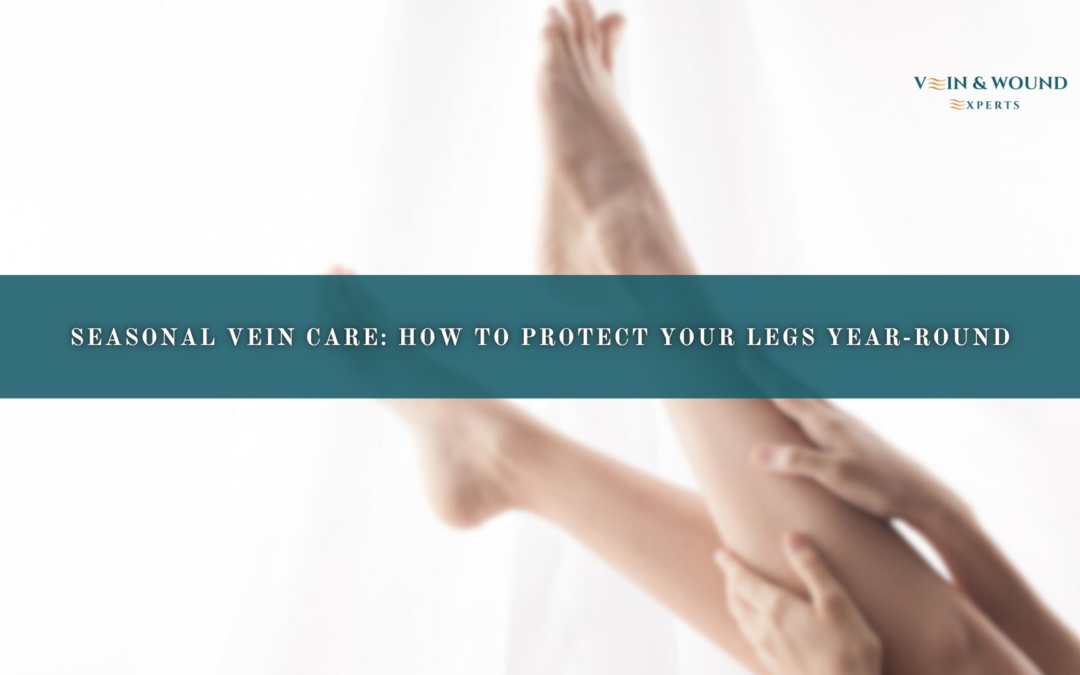Protecting Your Veins Through the Seasons

Seasonal changes can significantly impact vein health, causing symptoms to flare up depending on the weather. Proper seasonal vein care is essential for preventing discomfort and keeping your legs in optimal condition throughout the year.
How Weather Affects Vein Health 🌞❄️
The weather plays a crucial role in vein health. Extreme temperatures can affect circulation and cause your veins to become more visible, swollen, or painful. Cold temperatures can cause veins to constrict, reducing blood flow and leading to stiffness or discomfort. On the other hand, summer varicose veins are a common concern. Warm weather can cause veins to dilate, exacerbating symptoms of varicose veins and causing swelling, discomfort, and visible veins.
Tips to Prevent Flare-Ups 🦵
Caring for your veins throughout the year involves making lifestyle adjustments based on the weather to manage and prevent vein problems. Here are a few tips to help protect your veins throughout the year:
-
Stay Active Year-Round: Regular exercise improves circulation and strengthens veins. Whether walking, swimming, or cycling, maintaining an active lifestyle is essential for leg health in hot and cold weather.
-
Wear Compression Stockings: Compression stockings help reduce swelling and support circulation, especially on hot summer days when varicose veins tend to worsen. They can also help during the colder months when reduced circulation can lead to discomfort.
-
Lift Your Legs: Raising your legs at the end of the day improves blood flow and reduces swelling. Whether it’s winter or summer, elevating your legs helps prevent varicose veins and circulation issues caused by extreme temperatures.
-
Stay Hydrated: Staying hydrated during both hot and cold months is important for maintaining circulation. Dehydration can worsen symptoms of venous insufficiency and cause veins to appear more swollen and visible.
-
Avoid Prolonged Sitting or Standing: Whether it’s the heat of summer or the cold of winter, sitting or standing for long periods can cause blood to pool in your legs. Take breaks every 30 minutes to stretch or walk around, ensuring blood circulates properly.
Managing Varicose Veins in Summer 🩺

As the temperature rises, so does the risk of varicose veins worsening. Warmer weather causes veins to expand and makes it harder for blood to flow back to the heart. This can lead to discomfort, swelling, and increased visibility of varicose veins. Managing varicose veins in hot weather involves wearing compression stockings, staying cool, and avoiding long periods of standing. A cool shower or leg soak can also help reduce swelling and relieve discomfort.
Cold Weather and Circulation: What You Need to Know 🧊
During the colder months, circulation problems can become more pronounced due to the drop in temperature. As temperatures drop, veins constrict, which can cause discomfort, tightness, and swelling in your legs. Maintaining leg health during extreme temperatures requires adjusting your clothing, such as wearing warm layers and protecting your legs from the cold. You can also try warming up your legs with a heating pad to help maintain circulation and avoid stiffness or discomfort.
Key Takeaways for Year-Round Vein Care 🌟
To protect your veins throughout the year, be mindful of seasonal changes and adjust your lifestyle accordingly. Whether it’s managing varicose veins in hot weather or addressing circulation issues in the cold, making these small changes can have a big impact on your vein health. From staying active to wearing compression stockings, these simple steps can help ensure your veins remain healthy and free of discomfort, regardless of the season.
Andy Sharify
Position
